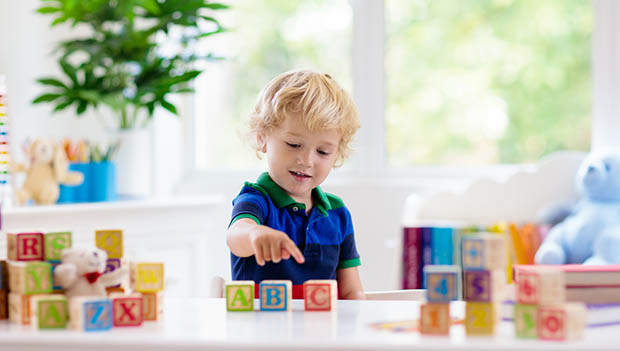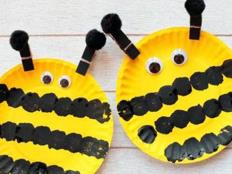
There's no specific answer for why some have a love for math and some don't. For some it boils down to left brain vs. right brain learners, and for others it's simply being a math person vs. not. Regardless of whether or not you love math, your child may be the exact opposite.
How do you inspire a child to connect with numbers when they're resistant? How do you help cultivate a love for math if you yourself are "not a math person?"
Me + Math = Headache, a book by Lee Wardlaw about a young boy who is struggling with math, may describe you or your child's experience with the subject so far, but hopefully some of the following suggestions will help you both rekindle and connect with the language of numbers in a positive way.
In fact, if the thought of turning to children's literature for math inspiration peaks your interest, check out Stanford's list of books to help inspire and nurture an appreciation of math.
Measuring
Break out the rulers and measuring tape! The beauty of using measurement to appeal to the language of numbers for your child simply comes down to purpose—if something must fit, numbers come to the rescue.
The question is, what to measure? You may have a project going on that requires measurement (shopping for new furniture or rugs, hanging curtains, watching your garden grow, building a new garden box), or you may need to create one (measure the width of every door, who is the tallest person in your house and by how much, what is the biggest room in the house). The ruler and measuring tape are simple tools with a great deal of opportunity for learning and engagement to help understand and apply all sorts of math concepts.
Once your child finds and records measurements, they can compare sizes (addition/subtraction), find areas and volumes (multiplication) and even get into the scales of measurements (number of feet vs. number of inches). Even if you have older kids, this type of activity can be helpful; they can convert, compare and even be held accountable to the precision of the tool when they get into more complex mathematics and statistical analysis.
Counting
Perhaps measuring feels over-ambitious due to your child's stage in development or the resources on hand. Number sense really starts with counting, so when in doubt, find something to count! Petals, lightbulbs, chairs, windows, corners, electrical sockets, the score of the game—if you can name it, you can count it.
Have your child help you with taking inventory of the fridge. If you have any kind of garden or fruit bearing tree, have them count your bounty! Use your view from the window and take count of all the birds you see, cars that drive by, dogs on a walk, etc. You can even have your child keep a counting journal of all the things they're keeping track of each day. If they're a sports fan, encourage them to follow player and team statistics and scores.
With a record of all the things they've counted, they can also run comparisons of "most" and "least" to practice subtraction and find totals to practice addition.
To add another layer of depth to any counting activity, you can count in groups by running tallies (grouped in fives) or by letting your child create symbols for groups of two or 10, and only recording that symbol when they've seen that many of whatever they are counting.
Estimating
Even adults have fun with this type of guessing game (see wedding and baby shower games)! Put a jar of something out on your counter each week for the whole family to guess the number of items they think the jar contains. After a week or so, take them out and count them (more counting practice!), and have some kind of celebration for the person who is the closest.
The most important aspect of estimation is the logic or skill that goes into making the guess. Before opening the container and revealing the exact quantity, have each family member support their predicted value with the logic that brought them to that point. The logic that can inform their guess will draw on counting, multiplying, measuring and more.
There is a lot of fun to be had in mixing estimating activities with measuring and counting activities. For example, if your child has measured the width and length of any tiled object, you can help them measure a single tile and estimate how many tiles are in that room in total to gain some practice and experience with division—then actually count them and compare!
Baking/Cooking
Break out the cookbooks! Aside from the fact that we all need to eat, there is a great deal of fun to be had in the kitchen. Considering liquid volumes and weight measurements in recipes add a new dimension to measurement and immediate purpose to the use of numbers.
Pick a favorite recipe and have your child work with you to measure, count and mix. If you have the extra resources, you can also experiment with switching up the recipe: What would happen if you didn't add the baking soda, the egg or the salt? This experience can help emphasize the importance of counting and working with numbers—ideally lessening any hint of intimidation/disinterest and increasing familiarity with numbers.
In the end, you'll have something delicious! If you make cookies, cake, pie or pizza, you can then cut, count, divide and disperse. This brings up mathematical concepts of addition/subtraction, fractions (halves/fourths/fifths), and the importance of numbers in sharing equitably.
Earning
Finally, if measuring and baking don't do the trick, an allowance can certainly pique the interest of any child with their eyes on some kind of prize. It's hard to argue that money doesn't drive our decisions on some level in life—we don't only need it to fulfill material wants but also needs (food, clothes, etc.). Help your child develop number sense along with responsibility as they maintain some kind of "account" or piggybank.
Some families may opt to use fake/game money over real dollars and coins, but the idea is the same with each in that number values are assigned to each piece. The need to exchange certain quantities of each type of coin or dollar to get a higher dollar is practice in a variety of number sense from addition/subtraction to multiplication/division. Working with money also gets into ratios, fractions and conversions. The more experience they have managing their accounts, the more familiar they'll become with both numbers and basic mathematic skills.
The goal is to have fun with all of the counting, estimating, measuring or earning. Help your kids set up and run a store that you shop at, or give them the opportunities they need to earn enough to make that first major purchase for something they have their eye on.
Whether our kids love math or not, it's all around us—sneaking into our lives when we cook, work, redesign our home, garden and participate in sports, so we might as well find opportunities to nurture a love for it as early and often as we can!
READ THIS NEXT: 12 Unique Puzzles to Challenge Growing Minds









Discuss This Article